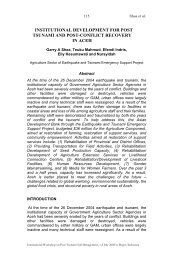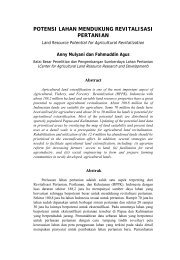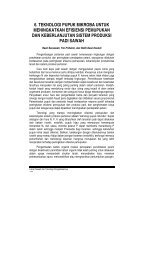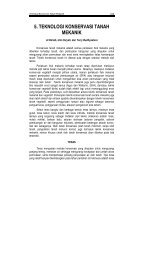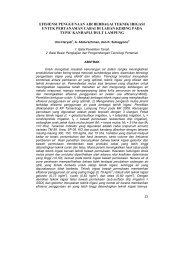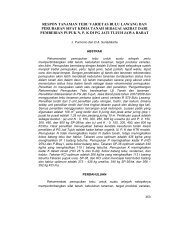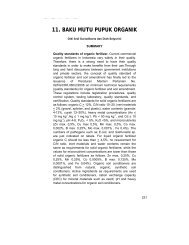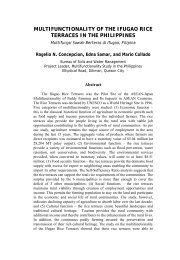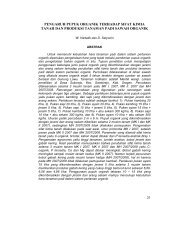Proceedings - Balai Penelitian Tanah
Proceedings - Balai Penelitian Tanah
Proceedings - Balai Penelitian Tanah
You also want an ePaper? Increase the reach of your titles
YUMPU automatically turns print PDFs into web optimized ePapers that Google loves.
166<br />
Chairunas<br />
Anjasmoro produced a significantly (>50%) higher yield than the<br />
current local variety but the other varieties in this trial did not<br />
significantly out-yield the local variety. Assessment of the data<br />
collected on other traits in the new varieties is needed to identify any<br />
other advantages or disadvantages compared to the local variety.<br />
There is no significant or consistent trend in yield response between<br />
the treatments. Heavy rain immediately after planting likely caused<br />
cross contamination between the treatments. The rate of manure in<br />
this trial was low (2 t/ha) and did not show a significant yield response.<br />
Manure may not be readily available locally or may already be<br />
allocated to other uses.<br />
SUGGESTIONS FOR FURTHER WORK<br />
A key message for soybean farmers is that there is no way of knowing<br />
the survival of Rhizobium from one season to another, and its<br />
distribution across a paddock is likely to be uneven, particularly if the<br />
paddock is also used for rice. In addition, the tsunami will have had a<br />
harmful impact on soil biota, especially Rhizobium. Therefore, it is<br />
best practice to inoculate every soybean crop in order to have good<br />
nodulation early to assist crop establishment and the provision of<br />
nitrogen throughout the growing cycle.<br />
The development of a soybean planting protocol for local PPL and<br />
leading farmers – including recommended varieties, inoculant, crop<br />
nutrition and plant spacing – is a priority, particularly in light of the<br />
Indonesian Government’s plan proposed plan for increasing soybean<br />
production in Aceh. Further agronomy trials on soybean crop nutrition,<br />
plant spacing, and weed management may be beneficial. Investigation<br />
of alternative local sources for use as organic amendments to improve<br />
soil structure and productivity. Coconut and other plant fibres appear<br />
to be abundant at this site and may be suited to composting or biochar<br />
production for soil amendment.<br />
Soybean is an ideal crop for developing IPM and reducing reliance on<br />
pesticides. This may be a suitable soybean growing area in which to<br />
introduce an IPM (and other) training programs for local farmers.<br />
Local farmers have expressed the desire for training and knowledge<br />
as opposed to one-off inputs.<br />
CONCLUSION<br />
Anjasmoro was identified as the best soybean variety in tsunamiaffected<br />
land, producing on average 3.4 ton.ha -1 . The use of manure<br />
and rice ash could could substitute for NPK fertilizer, but should be<br />
tested in field demonstrations to determine the economic rates for<br />
organic and inorganic fertilisers.<br />
International Workshop on Post Tsunami Soil Management, 1-2 July 2008 in Bogor, Indonesia



